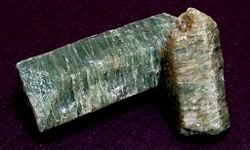Difference between revisions of "Apatite" - New World Encyclopedia
| Line 1: | Line 1: | ||
{{Claimed}} | {{Claimed}} | ||
| + | <<Check Amethyst Galleries for a broader definition of the Apatite group of minerals.>> | ||
| + | |||
{{Infobox mineral | {{Infobox mineral | ||
| name = Apatite | | name = Apatite | ||
Revision as of 00:08, 9 May 2007
<<Check Amethyst Galleries for a broader definition of the Apatite group of minerals.>>
| Apatite | |
|---|---|
 |
|
| General | |
| Category | Phosphate mineral group |
| Chemical formula | Ca5(PO4)3(F,Cl,OH) |
| Identification | |
| Color | Transparent to translucent, usually green, less often colorless, yellow, blue to violet, pink, brown.[1] |
| Crystal habit | Tabular, prismatic crystals, massive, compact or granular |
| Crystal system | Hexagonal Dipyramidal (6/m)[2] |
| Cleavage | [0001] Indistinct, [1010] Indistinct[2] |
| Fracture | Conchoidal to uneven[1] |
| Mohs Scale hardness | 5[1] |
| Luster | Vitreous[1] to subresinous |
| Refractive index | 1.634 - 1.638 (+.012, -.006)[1] |
| Optical Properties | Double refractive, uniaxial negative[1] |
| Birefringence | .002-.008[1] |
| Pleochroism | Blue stones - strong, blue and yellow to colorless. Other colors are weak to very weak.[1] |
| Streak | White |
| Specific gravity | 3.16 - 3.22[2] |
| Diaphaneity | Transparent to translucent[2] |
Apatite is a group of phosphate minerals, usually referring to hydroxylapatite, fluorapatite, and chlorapatite, named for high concentrations of OH-, F-, or Cl- ions, respectively, in the crystal. The formula of the admixture of the three most common species is written as Ca5(PO4)3(OH, F, Cl), and the formulae of the individual minerals are written as Ca5(PO4)3(OH), Ca5(PO4)3F and Ca5(PO4)3Cl, respectively.
Apatite is one of few minerals that are produced and used by biological micro-environmental systems. Hydroxylapatite is the major component of tooth enamel. A relatively unique form of apatite in which most of the OH groups are absent and containing many carbonate and acid phosphate substitutions is a large component of bone material.
Fluorapatite (or fluoroapatite) is more resistant to acid attack that is hydroxyapatite. For this reason, toothpaste typically contain a source of fluoride anions (e.g. sodium fluoride, sodium monofluorophosphate). Similarly, fluoridated water, allow exchange in the teeth of fluoride ions for hydroxy groups in apatite. Too much fluoride results in dental fluorosis and/or skeletal fluorosis.
In the United States, apatite is often used to fertilize tobacco. It partially starves the plant of nitrogen, which gives American cigarettes a different taste from those of other countries.
Fission tracks in apatite are commonly used to determine the thermal history of orogenic (mountain) belts and of sediments in sedimentary basins.
Phosphorite is the name given to impure, massive apatite.
Gemology
Apatite is infrequently used as a gemstone. Transparent stones of clean color have been faceted, and chatoyant specimens have been cabochon cut.[1] Chatoyant stones are known as cat's-eye apatite,[1] transparent green stones are known as asparagus stone,[1] and blue stones have been called moroxite.[3] Crystals of rutile may have grown in the crystal of apatite so when in the right light, the cut stone displays a cat's eye effect. Major sources for gem apatite are:[1] Brazil, Burma, and Mexico. Other sources include:[1] Canada, Czechoslovakia, Germany, India, Madagascar, Mozambique, Norway, South Africa, Spain, Sri Lanka, and the United States.
See also
Notes
- ↑ 1.00 1.01 1.02 1.03 1.04 1.05 1.06 1.07 1.08 1.09 1.10 1.11 1.12 Gemological Institute of America, GIA Gem Reference Guide 1995, ISBN 0-87311-019-6
- ↑ 2.0 2.1 2.2 2.3 Apatite Mineral Data. Webmineral.com. Retrieved May 8, 2007.
- ↑ Streeter, Edwin W., Moroxite Precious Stones and Gems 6th ed., George Bell and Sons, London, 1898, p306. Retrieved May 8, 2007.
ReferencesISBN links support NWE through referral fees
- Farndon, John. 2006. The Practical Encyclopedia of Rocks & Minerals: How to Find, Identify, Collect and Maintain the World's best Specimens, with over 1000 Photographs and Artworks. London: Lorenz Books. ISBN 0754815412.
- Klein, Cornelis, and Barbara Dutrow. 2007. Manual of Mineral Science. 23rd ed. New York: John Wiley. ISBN 978-0471721574.
- Pellant, Chris. 2002. Rocks and Minerals. Smithsonian Handbooks. New York: Dorling Kindersley. ISBN 0789491060.
- Shaffer, Paul R., Herbert S. Zim, and Raymond Perlman. 2001. Rocks, Gems and Minerals. Rev. ed. New York: St. Martin's Press. ISBN 1582381321.
- Mineral Gallery. 2006. The Mineral Apatite. Amethyst Galleries. Retrieved May 8, 2007.
- Mineral Gallery. 2006. The Apatite Group of Minerals. Amethyst Galleries. Retrieved May 8, 2007.
External links
- Apatite. Mindat.org. Retrieved May 8, 2007.
- Apatite Group. Mindat.org. Retrieved May 8, 2007.
- Apatite Mineral Data. Webmineral.com. Retrieved May 8, 2007.
Credits
New World Encyclopedia writers and editors rewrote and completed the Wikipedia article in accordance with New World Encyclopedia standards. This article abides by terms of the Creative Commons CC-by-sa 3.0 License (CC-by-sa), which may be used and disseminated with proper attribution. Credit is due under the terms of this license that can reference both the New World Encyclopedia contributors and the selfless volunteer contributors of the Wikimedia Foundation. To cite this article click here for a list of acceptable citing formats.The history of earlier contributions by wikipedians is accessible to researchers here:
The history of this article since it was imported to New World Encyclopedia:
Note: Some restrictions may apply to use of individual images which are separately licensed.
